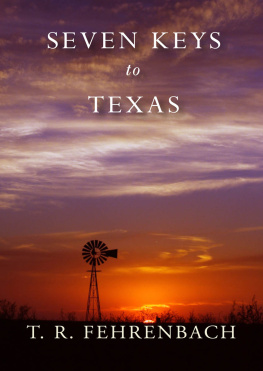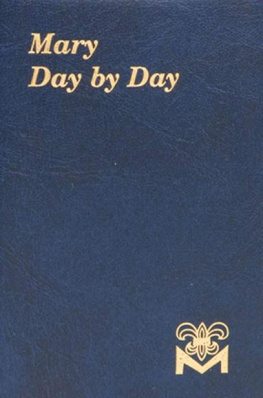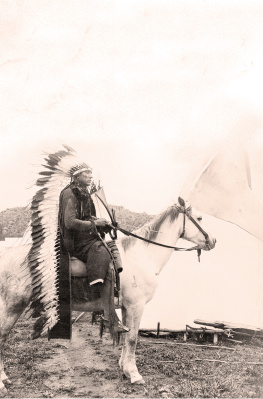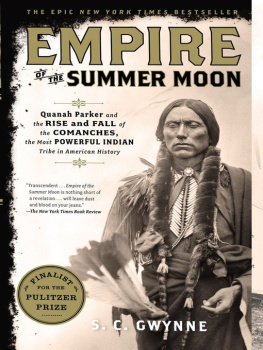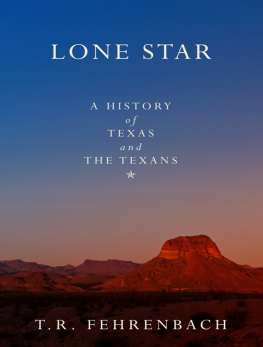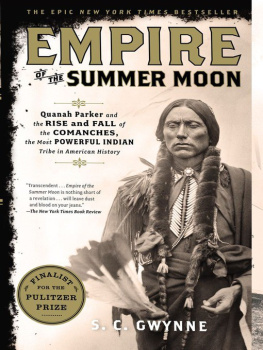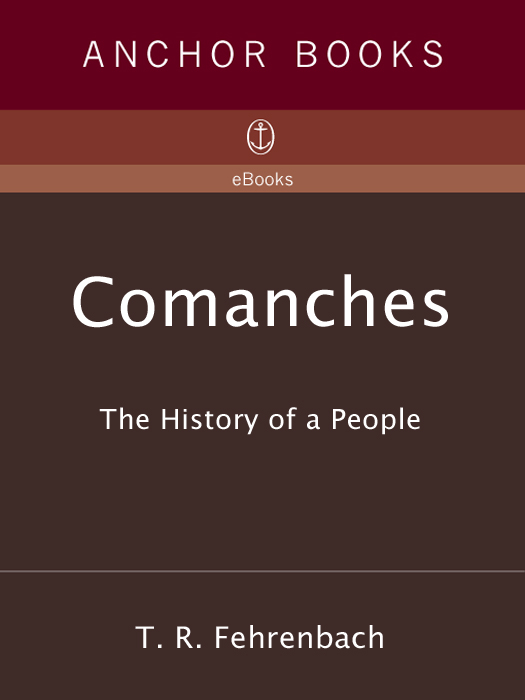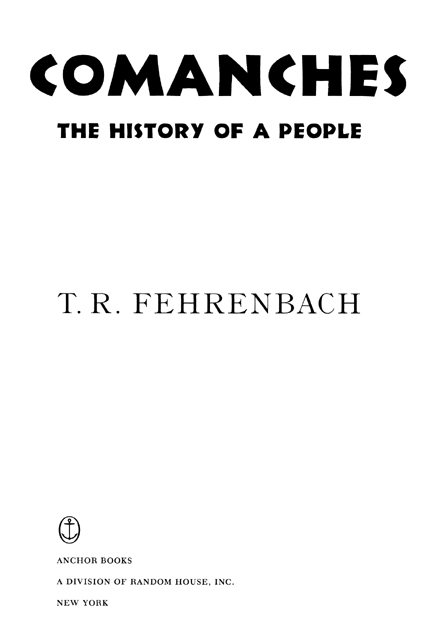ALSO BY T.R. FEHRENBACH
Fire and Blood: A History of Mexico
The Fight for Korea
The United Nations in War and Peace
Lone Star: A History of Texas and the Texans
Greatness to Spare: The Heroic Sacrifices of the Men
Who Signed the Declaration of Independence
F.D.R.s Undeclared War
Crossroads in Korea
Swiss Banks
This Kind of War
FIRST ANCHOR BOOKS EDITION, APRIL 2003
Copyright1974 by T.R. Fehrenbach
All rights reserved under International and Pan-American
Copyright Conventions. Published in the United States by Anchor Books, a division of Random House, Inc., New York, simultaneously in Canada by Random House of Canada Limited, Toronto. Originally published in hardcover in the United States by Alfred A. Knopf, Inc.,
New York, in 1974.
Anchor Books and colophon are registered trademarks of Random House, Inc.
Grateful acknowledgment is made to the following for permission to reprint the illustrations listed on pages ix-xii: Museum of the American Indian, New York, New York, Heye Foundation; Rare Book Division, The New York Public Library, Astor, Lenox and Tilden Foundations; The New-York Historical Society, New York City; The Smithsonian Institution National Anthropological Archives, Bureau of American Ethnology Collection; The University of Texas Press, Austin; Western History Collections, University of Oklahoma Library; The U.S. Army Field Artillery Center and Fort Sill Museum, Fort Sill, Oklahoma; The National Collection of Fine Arts, Smithsonian Institution.
The Library of Congress cataloged the Knopf edition as follows:
Fehrenbach, T. R.
Comanches: the destruction of a people.
1. Comanche IndiansHistory. I. Title.
E99.C85F44 970.3 73-20761
eISBN: 978-0-307-77400-2
www.anchorbooks.com
v3.1
To those who have seldom been too cold, hot, or wet, never really hungry, and confidently expect to see many tomorrows, a people who had none of these advantages come as something of a shock. Yet, they survived, even thrived, and were happy with their ways.
To Europeans and Texans it was astonishing and insufferable that such a people should prefer their own gods, food, and customs to civilizations blessings.
But they did, and they clung to these ancestral ways.
And for this they perished.
To persevere to such ultimate tragedy is a highway to continuing remembrance.
W. W. NEWCOMB, JR .
CONTENTS
I DEATH IN THE HIGH COUNTRY:
The People and the American Indians
II FAILED EMPIRES:
The People and the French and Spaniards
III SMOKE AND TEARS:
The People and the Mexicans
IV BLOOD ON THE MOON:
The People and the Texans
V THE GRAVEYARD PLAINS:
The People and the Americans
ILLUSTRATIONS
ILLUSTRATIONS IN TEXT
Nerm woman, twentieth century. Rare Book Division, The New York Public Library, Astor, Lenox and Tilden Foundations
Bear claw charm with feathers. Photograph courtesy of Museum of the American Indian, Heye Foundation
Nerm man, twentieth century. Rare Book Division, The New York Public Library, Astor, Lenox and Tilden Foundations
Warrior in medicine paint, c. 1884. Photograph courtesy of Museum of the American Indian, Heye Foundation
Warriors practicing mounted maneuvers. Drawing by George Catlin, c. 1836. Courtesy of The New-York Historical Society, New York City
Tipis. Late nineteenth century. Smithsonian Institution National Anthropological Archives, Bureau of American Ethnology Collection
Womans beaded buckskin dress. Photograph courtesy of Museum of the American Indian, Heye Foundation111
Horse hide war shield. Photograph courtesy of Museum of the American Indian, Heye Foundation
Pawnees capturing and breaking wild ponies. Drawing by George Catlin, c. 1836. Courtesy of The New-York Historical Society, New York City
Plains metal hand axes or tomahawks. Photograph courtesy of Museum of the American Indian, Heye Foundation
Comanche encampment. Drawing by George Catlin, c. 1836. Courtesy of The New-York Historical Society, New York City
Warriors in council, with brass ceremonial pipes. Drawing by George Catlin, c. 1836. Courtesy of The New-York Historical Society, New York City
Warrior in winter dress, c. 186774. Smithsonian Institution National Anthropological Archives, Bureau of American Ethnology Collection
Comanches on the move. Drawing by George Catlin, c. 1836. Courtesy of The New-York Historical Society, New York City
Texas Ranger, c. 1840. Contemporary drawing.
Ranger camp. Nineteenth-century drawing.
Jack Hays, c. 1846. Contemporary portrait.
Battle scene, engraved on Colts martial revolvers, 1840s.
Ranger Captain Samuel H. Walker. Contemporary portrait.
Ranger Captain Ben McCulloch. Drawing by Lonnie Rees. Taken from Walter P. Webb, The Texas Rangers, revised edition, 1965, University of Texas Press, Austin
Battle of Plum Creek. An engraving by T. J. Owen, from a woodcut by O. Henry. Taken from J. W. Wilbarger, Indian Depredations in Texas, 1889, Hutchings Printing House, Austin
Attack on wagon train by Plains Indians. Nineteenth-century lithograph. Western History Collections, University of Oklahoma Library
Meeting of U.S. 1st Regiment of Dragoons and Comanches under flag of truce, Indian Territory, 1836. Drawing by George Catlin. Courtesy of The New-York Historical Society, New York City
John R. Baylor in Confederate uniform, c. 1862.
The Koh-eet-senko Set-tainte or White Bear, c. 1870. Smithsonian Institution National Anthropological Archives, Bureau of American Ethnology Collection
Par-roowah Sermehno or Ten Bears, civil chief of the Yampahreekuh. Smithsonian Institution National Anthropological Archives, Bureau of American Ethnology Collection
Lawrie Tatum with young Kiowas, c. 1872. Smithsonian Institution National Anthropological Archives, Bureau of American Ethnology Collection
Mow-way or Shaking Hand, chief of the Kuhtsoo-ehkuh, c. 186774. Smithsonian Institution National Anthropological Archives, Bureau of American Ethnology Collection
The Kiowa warrior Ado-eete or Big Tree, c. 1870. Smithsonian Institution National Anthropological Archives, Bureau of American Ethnology Collection
The Koh-eet-senko Set-tank (Setangya) or Sitting Bear. Smithsonian Institution National Anthropological Archives, Bureau of American Ethnology Collection
Quanah Parker. Western History Collections, University of Oklahoma Library
Scalped buffalo hunter, near Fort Dodge, Kansas, 1868. Smithsonian Institution National Anthropological Archives, Bureau of American Ethnology Collection
Comanches on the reservation, c. 186774. Smithsonian Institution National Anthropological Archives, Bureau of American Ethnology Collection
Comanche feathered war bonnet. Photograph courtesy of Museum of the American Indian, Heye Foundation


